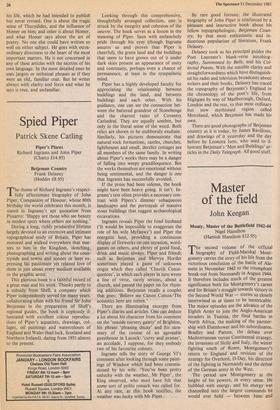Spied Piper
Patrick Skene Catling
Piper's Places Betjeman Country Frank Delaney (Hodder £8.95) The theme of Richard Ingrams's respect- fully affectionate biography of John Piper, Companion of Honour, whose 80th birthday the world celebrates this month, is stated in Ingrams's apt quotation from Pissarro: `Happy are those who see beauty in modest spots where others see nothing.'
During a long, richly productive lifetime largely devoted to an extensive and intimate topographical study of Britain, Piper has motored and walked everywhere that mat- ters to him in the Kingdom, sketching, photographing and writing about the coun- tryside and towns and sooner or later ex- pressing his passionate yet relaxed love of them in just about every medium available to the graphic artist.
This glorious book is a faithful record of a great man and his work. Thanks partly to a subsidy from Shell, a company which Piper independently served for many years, collaborating often with his friend Sir John Betjeman in the preparation of Shell's regional guides, the book is copiously il- lustrated with excellent colour reproduc- tions of Piper's aquatints, drawings, col- lages, oil paintings and watercolours of England and Wales (bad luck, Scotland and Northern Ireland), dating from 1931 almost to the present.
Looking through this comprehensive, thoughtfully arranged collection, one is struck by the integrity and cohesion of the oeuvre. The book serves as a lesson in the meaning of Piper. Seen with melancholy pride through his eyes (though ingrams assures us and proves that Piper is cheerful), the green land and the buildings that seem to have grown out of it under dark skies present an appearance of unity and continuity, perhaps even a chance of permanence, at least in the sympathetic mind.
Piper has a highly developed faculty for appreciating the relationship between buildings and the land, and between buildings and each other. With his guidance, one can see the connection bet- ween the battered grandeur of Stonehenge and the charred ruins of Coventry Cathedral. They are equally sombre, but only in the literal sense of the word. Both relics are shown to be stubbornly exultant. Similarly, his pictures demonstrate that natural rock formations, castles, churches, lighthouses and small, derelict cottages are all members of the same family. In writing about Piper's works there may be a danger of falling into weepy grandiloquence. But the works themselves are emotional without being sentimental, and the danger is one that ingrams has successfully avoided.
If the prose had been solemn, the book might have been heavy going. It isn't. In- grams's text often provides a necessary con- trast with Pipers's dimmer subaqueous landscapes and the portrayals of massive stone buildings that suggest archaeological excavations.
Ingrams reveals Piper the fond husband ('It would be impossible to exaggerate the role of his wife Myfanwy') and Piper the energetic host, providing a continuous display of fireworks on one occasion, word- games on others, and plenty of good food, drink and music always. Piper and friends such as Betjeman and Mervyn Horder sometimes played a game of unknown origin which they called 'Church Conse- quences', in which each player in turn wrote a line of verse, rarely serious, about a church, and passed the paper on for rhym- ing additions. Betjeman recalls a couplet that goes: `Believe me Canon Cotton/The acoustics here are rotten.'
There are illuminating excerpts from Piper's diaries and articles. One can deduce a lot about his character from his comment on the 'seaside nursery gaiety' of Brighton, his phrase 'pleasing decay' and his sum- mary of the cuisine of an agreeable guesthouse in Lacock: 'curry and prunes', an accolade, I suppose, for they embody two of his favourite colours.
Ingrams tells the story of George VI's comment after looking through some paint- ings of Windsor which had been commis- sioned by his wife. 'You've been pretty unlucky with the weather, Mr Piper', the King observed, who must have felt that some sort of polite jemark was called for. At any rate, as this book testifies, the weather was lucky with Mr Piper. By rare good fortune, the illustrated biography of John Piper is reinforced by a pleasant and instructive book about his fellow topographologist, Betjeman Coun- try, by that most enthusiastic and in- dustrious populariser of literature, Frank Delaney.
Delaney took as his principal guides the Poet Laureate's blank-verse autobiog- raphy, Summoned by Bells, and his Col- lected Poems. With the sensible clarity and straightforwardness which have distinguish- ed his radio and television broadcasts about writers and their books, Delaney has traced the topography of Betjeman's England in the chronology of the poet's life, from Highgate by way of Marlborough, Oxford, London and the rest, to that most ordinary but now mythisised region called Metroland, which Betjeman has made his own.
There are good photographs of Betjeman country as it is today, by James Ravilious, and drawings of it yesterday and the day before by Leonora Ison, who used to il- lustrate Betjeman's 'Men and Buildings' ar- ticles in the Daily Telegraph. All good stuff.














































 Previous page
Previous page